Updated: December 7, 2025
Greece › Mykonos Travel Guide
By Santorini Dave
Popular Pages
• Best Towns in Mykonos
• Best Beaches in Mykonos
• Best Hotels in Mykonos
• Best Tours
• Best Restaurants
• Best Bars & Nightlife
• Best Beach Clubs
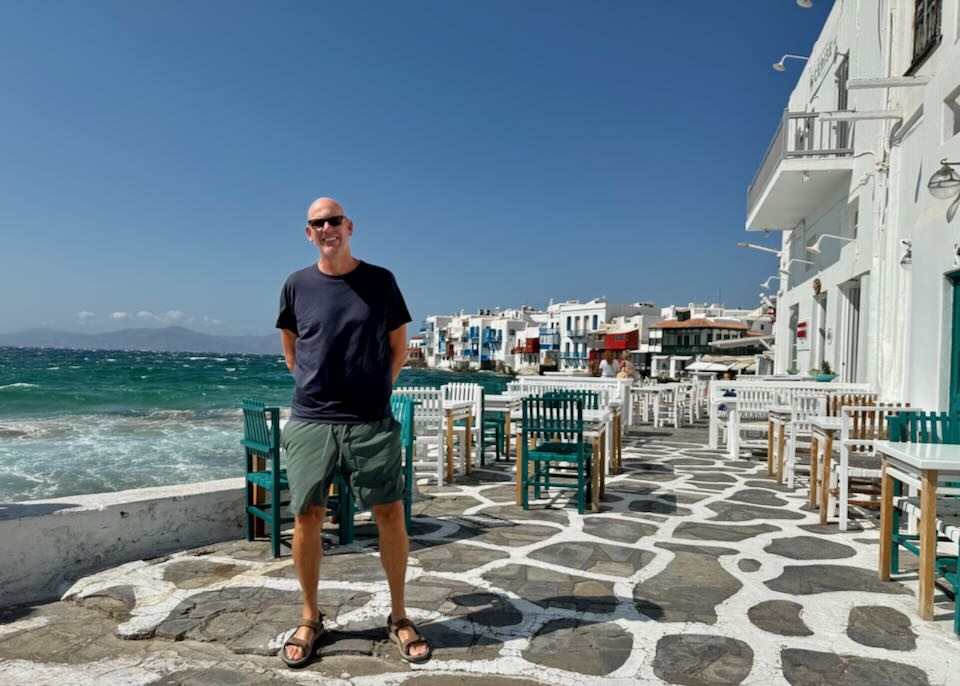
I love Mykonos. I’ve been visiting regularly since 1998, when I did a full tour of the Cyclades with my brother. From the best luxury hotels and lively beach clubs to the quietest tavernas, I know the island inside and out. This is my guide to Greece’s most glamorous island.
Mykonos is the glamour capital of Greece. Famous as the ultimate party island, it’s also home to the most beautiful main town (Chora) in the Cyclades and arguably the best golden sand beaches in the country. It is a place of contrasts: you’ll find quiet whitewashed chapels next to high-end boutiques, and traditional tavernas minutes away from world-famous beach clubs and nightlife. The party scene is legendary but easy to avoid if you prefer a relaxing vacation of swimming, shopping, and great food. It’s also an ideal hub for island hopping, with Santorini, Naxos, and Paros just a short ferry ride away.
My 2026 Mykonos Travel Guide
- Skip to our Mykonos FAQ
Mykonos Basics
Mykonos Hotels
- Best Hotels in Mykonos
- Best New Hotels in Mykonos
- Best Hotels for Families
- Best Hotels for Couples
- Hotels with Private Pools
- Best Cheap Hotels
- Best Beach Hotels
- Wheelchair Accessible Hotels
- Mykonos Town Hotels
- Mykonos Hotel Reviews
Mykonos Activities
- Best Tours & Things to Do in Mykonos
- Best Restaurants
- Best Bars & Clubs
- Best Beach Clubs
- Best Mykonos Beaches
- Mykonos Water Taxi
- Visiting Delos from Mykonos
Mykonos Trip Planning
- Mykonos Ferry Port Guide
- Mykonos Car Rental
- Helicopter Tours & Transfers
- Athens to Mykonos – Fly or Ferry?
- Mykonos to Santorini – Fly or Ferry?
- Athens to Mykonos
- Mykonos to Athens
- Mykonos to Santorini
- Santorini to Mykonos
Latest Articles & My Travel Newsletter
Frequently Asked Questions about Mykonos
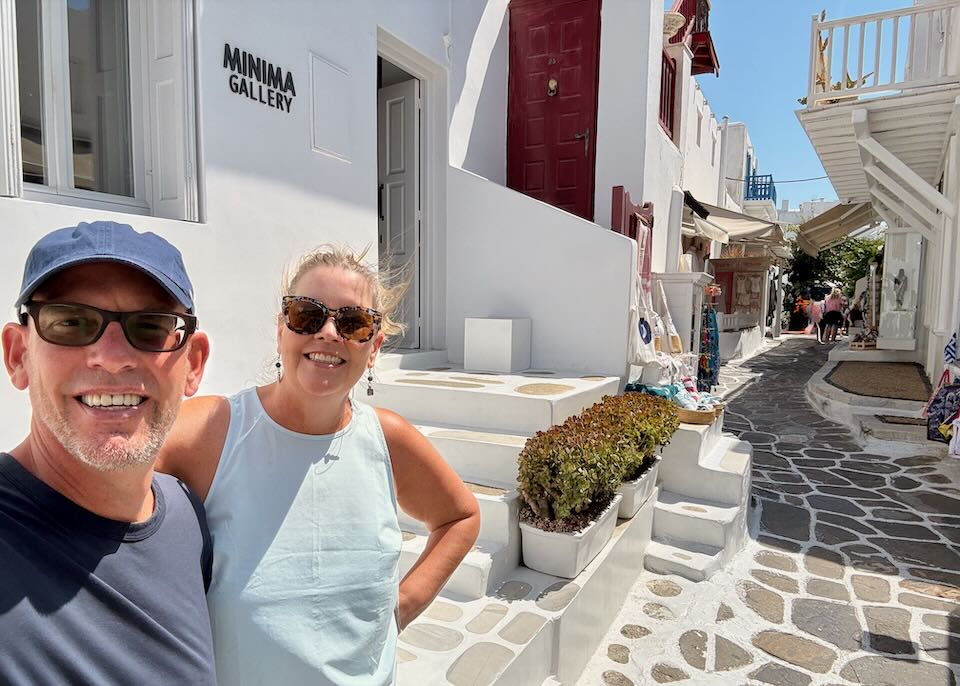
My wife and I in Mykonos Town, the largest community on the island, the hub of the Mykonos bus system, and home to an insane number of luxury hotels, great restaurants, and trendy clubs.
How Long Should I Stay in Mykonos?
For a first-time visit during the bustling summer months, I recommend aiming for 3 to 4 full days (4 or 5 nights).
This gives you the perfect amount of time for:
- Day 1: Exploring the maze of Mykonos Town (Chora), seeing the Windmills, and having sunset cocktails in Little Venice.
- Day 2: A full beach day. Use the water taxi to hop between the famous south coast beaches and beach clubs (like Platis Gialos, Paraga, and Paradise).
- Day 3: A morning boat trip to the ancient ruins of Delos (a must-do), leaving the afternoon for relaxation or shopping.
- Day 4: Renting a car to explore the “quiet side” of the island: the Armenistis Lighthouse, the village of Ano Mera, and the undeveloped northern beaches like Agios Sostis.
This pace allows you to experience the main draws — history, beaches, town exploration, and nightlife — without feeling like you’re constantly running from place to place. If you are purely focused on parties and beaches, 3 days is sufficient, but for a well-rounded trip, 4 days is the sweet spot.
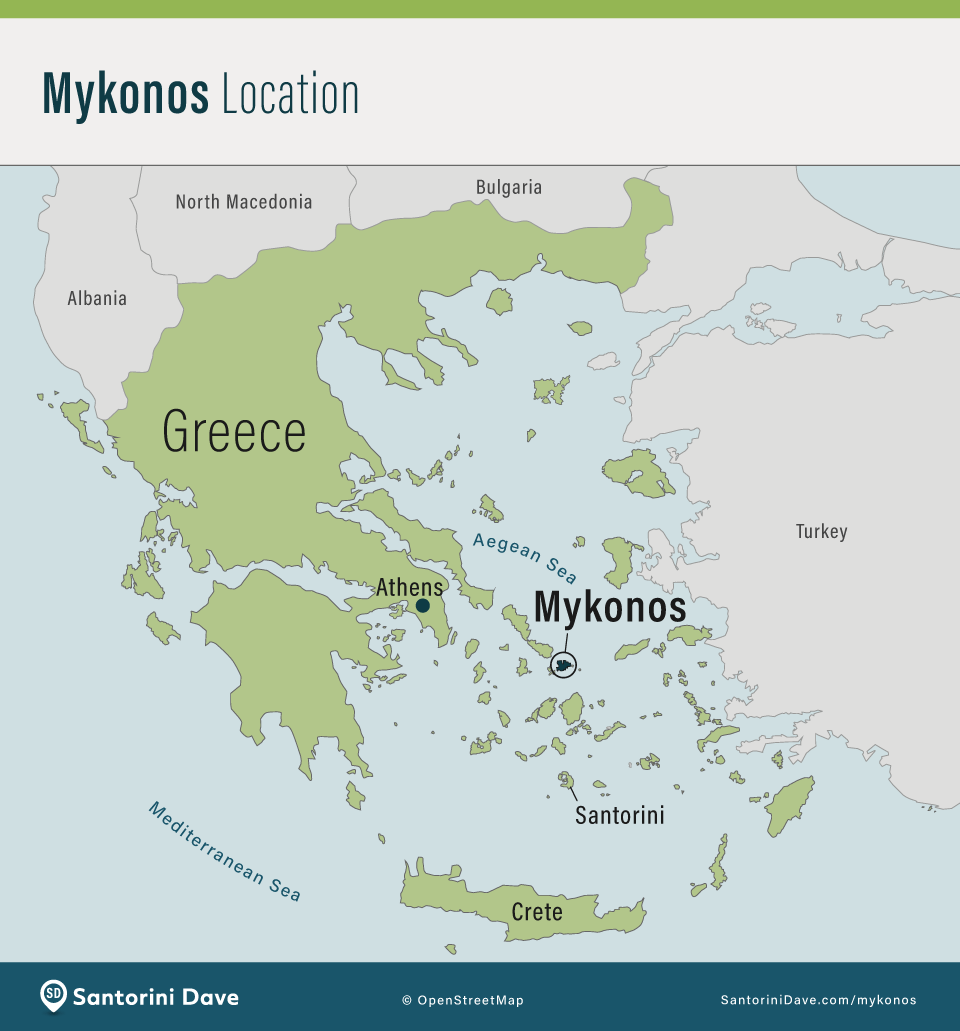
What’s the easiest way to get to Mykonos – fly or ferry?
The “easiest” choice depends entirely on where you are starting your journey.
Fly to Mykonos if…
- You are arriving from outside Greece: Many European hubs (London, Paris, Rome) offer direct seasonal flights. This is the fastest way.
- You are already at Athens Airport: If you are landing at ATH, a 40-minute connecting flight is much faster and easier than taking a taxi to the ferry port.
- You get seasick: The Aegean can be windy (especially in July/August), and high-speed ferries can be bumpy. Flying avoids this completely.
Take the Ferry to Mykonos if…
- You are in Athens City Center: It is easier to take the Metro to Piraeus Port than to trek back out to the airport.
- You are Island Hopping: If coming from Santorini, Naxos, or Paros, the ferry is your standard option.
- You have heavy luggage: Ferries have no weight limits and no extra fees for bags.
- You want the scenic route: Conventional ferries (like Blue Star) allow you to sit on the open deck and enjoy the sea, which you cannot do on a plane or a high-speed ferry.
How Long is the Ferry Ride?
Ferry times vary by vessel type (High-Speed vs. Conventional):
- From Piraeus (Athens): 2.5 hours (High-Speed) to 5 hours (Blue Star).
- From Rafina (Near Airport): 2 to 4 hours. Rafina is a great alternative port if you are landing at the airport but prefer the ferry; it is only a 30-minute taxi ride away.
- From Santorini: 2 to 3 hours (High-Speed).
- From Naxos/Paros: 45 minutes to 1.5 hours.
What is the best month to visit Mykonos?
The best time to visit depends entirely on what you want: the world-famous party scene, a relaxing beach holiday, or a quiet escape.
High Season: July & August (The Party Peak)
- The Vibe: This is when Mykonos lives up to its reputation. The beach clubs (Scorpios, Nammos) are packed, world-famous DJs play every night, and the energy is non-stop.
- Weather: Hot and sunny (30°C+). The strong Meltemi winds are common in August; they cool the island down but can make the sea choppy.
- Crowds & Prices: Maximum capacity. Hotels are expensive and book out months in advance. Traffic and crowds in town are intense.
Shoulder Season: June & September (The “Smart” Choice)
- The Vibe: The sweet spot. The beach clubs and nightlife are in full swing, but the crushing crowds of August are gone. It feels lively but sophisticated.
- Weather: Fantastic. September is particularly good because the sea is at its warmest after heating up all summer.
- Value: Prices are still high, but you get better value and availability than in peak summer.
Low Shoulder: May & October (For Relaxation)
- The Vibe: Much quieter. In May, the island is waking up; in October, it is winding down. The massive parties are gone, making it perfect for couples or families who want to explore the town and beaches in peace.
- Swimming: The sea is too cold for most in May, but usually still pleasant in early October.
Low Season: November to April (Closed)
- The Reality: Unlike Santorini, Mykonos effectively shuts down in winter. Beach clubs, most hotels, and restaurants close completely. Visit only if you want total solitude and don’t mind cool, wet weather.
My Recommendation:
For the best mix of warm swimming water, great weather, and a buzzing (but manageable) nightlife scene, September is the single best month to visit.
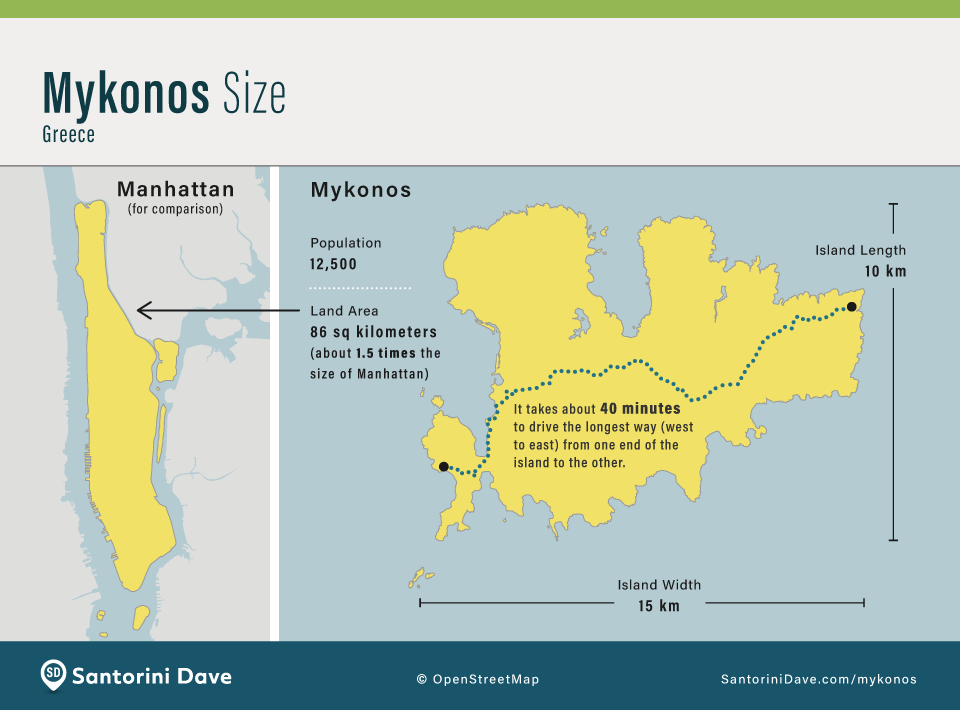
What is the best way to get around Mykonos island?
Figuring out how to navigate Mykonos is key to making the most of your trip. The island isn’t huge, but getting from the charming maze of Mykonos Town to the stunning beaches requires some planning. Here’s a rundown of your options:
Public Bus (KTEL): This is the most budget-friendly option and surprisingly efficient for reaching popular spots.
• Hubs: There are two main bus stations in Mykonos Town: Fabrika (South Station) and the Old Port (North Station). They aren’t directly connected by bus, requiring about a 15-20 minute walk through town between them.
• Routes: Fabrika generally serves the popular southern beaches like Ornos, Agios Ioannis, Platis Gialos, Paraga, and Paradise Beach. The Old Port station traditionally serves Ano Mera village and beaches like Kalafatis, Elia, Kalo Livadi, and Agios Stefanos (though always double-check current schedules as routes can change).
• Pros: Cheap (tickets cost around €2 per ride, pay the driver in cash or buy at kiosks/machines), frequent service to popular beaches in high season (often every 30-60 minutes during the day, some run late).
• Cons: Can get very crowded in July/August, routes are fixed, doesn’t reach remote areas, schedules change often.
• Timetables: Check the KTEL Mykonos website or the posted schedules at the stations upon arrival for the latest info.Rental Car: Offers the most freedom and flexibility.
• Pros: Explore the entire island at your own pace, visit remote beaches and inland villages like Ano Mera easily, enjoy air conditioning, good for families or groups.
• Cons: Parking in Mykonos Town is extremely difficult and expensive. Roads can be narrow, winding, and busy. Rental costs ($30-$70+ per day plus gas) add up.
• Best For: Travelers staying outside Mykonos Town or the main beach hubs, or those planning significant exploration beyond the bus routes. Book well in advance for summer (especially if you want a vehicle with automatic transmission).ATV/Scooter: A very popular, fun way to get around.
• Pros: Easier to park than cars, more affordable than cars (€20-€50+ per day), great for navigating narrower roads, offers an open-air experience.
• Cons: Safety is a major concern. Roads have traffic, can be poorly lit at night, and surfaces aren’t always perfect. Accidents involving tourists on ATVs/scooters are unfortunately common. Do not rent one if you are not an experienced rider. (Limited luggage space and can’t lock your stuff inside for beach visits.)
• Best For: Confident, experienced riders looking for flexibility and easier parking than a car.Water Taxi / Sea Bus: A fantastic way to travel between certain points.
• Beach Water Taxis: These traditional wooden boats (caiques) connect the popular southern beaches. You can hop on at Ornos or Platis Gialos and travel to Paraga, Paradise, Super Paradise, Agrari, and Elia. It’s a scenic and fun way to beach hop! Expect to pay around €10 for a return trip or €20 for an all-day pass. Service is weather-dependent and typically runs from mid-morning to early evening in high season.
• Port Sea Bus: Connects the New Port (Tourlos), where all ferries arrive, with the Old Port, right on the edge of Mykonos Town. It runs frequently (about every 30 minutes), costs only €2, and is a super convenient way to get to/from your ferry, avoiding road traffic. The trip from Mykonos Town (Old Port) to Tourlos (New Port/ferry port) takes 8 minutes.Taxis/Uber: Be warned – taxis are notoriously difficult to find in Mykonos. (I use Uber to call rides.)
• Pros: Direct, point-to-point service. Uber works with the existing taxis and is often a more reliable way to call a taxi.
• Cons: There are less than 40 official taxis serving the entire island. This means long waits, especially during peak hours, at night, or upon ferry arrival. They can be expensive (€20-€40+ for relatively short trips). Hard to flag down; best bet is finding a rank (Airport, New Port, Fabrika square) or using the Uber app.
• Alternative: Use Welcome Pickups – especially when you want someone to be waiting for you at the ferry port.Walking: Perfect for exploring the beautiful, pedestrianised lanes of Mykonos Town itself. You can wander for hours. However, it’s not practical for reaching beaches or other parts of the island due to distances and limited sidewalks.
The public bus picking up passengers at Mykonos Airport. It goes directly to Fabrika station in Mykonos Town.
From Mykonos Airport (JMK):
• Bus: The public bus runs from the airport to the Fabrika station in Mykonos Town. The trip takes about 10-15 minutes and costs €2. From Fabrika, you can walk into town or catch another bus to beaches like Ornos or Platis Gialos. Bus frequency varies; check the schedule, but don’t rely on it if you’re in a hurry. It stops directly in front of Arrivals.
• Taxi: There’s a taxi rank outside arrivals. Expect a queue in high season. The fare to Mykonos Town is roughly €20+, and to Ornos or Platis Gialos around €30+ (plus potential surcharges for luggage or nighttime travel). Try Uber if you don’t see any taxis.
• Pre-booked Transfer: This is often the easiest and most reliable option. Arrange through your hotel or book online with a service like Welcome Pickups or a local provider. Drivers meet you at arrivals. Expect to pay around €30-€40 for a standard car to Town/Ornos/Platis Gialos. Worth it for peace of mind.
• Rental Car: If renting a car, arrange to pick it up at the airport. Desks are located in the arrivals area.From the Ferry Port (New Port – Tourlos):
• Sea Bus: Your best budget bet for getting to Mykonos Town. Follow the signs inside the port area (usually a short walk to the left as you disembark) to the Sea Bus dock. It runs every 30 minutes or so to the Old Port (edge of Mykonos Town) for just €2. From the Old Port, you can walk into town.
• Public Bus: Buses sometimes meet ferries and go to Fabrika station or the airport, but the Sea Bus to the Old Port is often more frequent and convenient for accessing Mykonos Town itself.
• Taxi: There’s a taxi rank, but again, expect long queues and limited availability. Fare to Mykonos Town is around €20+, to Ornos/Platis Gialos perhaps €30-€40+. Uber is often a better option.
• Pre-booked Transfer with Welcome Pickups: Highly recommended, especially with luggage. Arrange beforehand via your hotel or an online service for a hassle-free pickup directly at the port. Costs are similar to taxis.
• Walk: It’s a long 2-3km from the New Port to most Mykonos Town hotels – not ideal with bags on a hot day along a busy road.My Recommendation:
For most visitors, a combination works best. Pre-book your arrival transfer for a stress-free start. Use the excellent public buses for getting between Mykonos Town and the main beaches. Enjoy walking within Mykonos Town. Use the water taxis for a fun day of beach hopping along the south coast. Only rent a car/ATV if you’re experienced, understand the risks with ATVs, need the flexibility, and have the patience for parking. Avoid relying solely on taxis due to scarcity.Delos Island, a short boat ride and wonderful day trip from Mykonos, is a UNESCO World Heritage Site and the mythical birthplace of Apollo and Artemis. Like with all historical sites in Greece, I highly recommend getting a tour guide when visiting.
What is the history of Mykonos?
Mykonos has a history defined by two distinct eras: its ancient connection to the sacred island of Delos, and its modern transformation from a poor fishing outpost to a global luxury icon.
Mythology & Ancient History
According to legend, Mykonos was formed from the petrified bodies of the Giants defeated by Hercules during the Gigantomachy (the war between Gods and Giants). In antiquity, the island was largely overshadowed by its neighbor, Delos. Delos was the sacred birthplace of Apollo and Artemis, and Mykonos served primarily as a supply and transit point for the pilgrims visiting the holy sanctuary.The Windmills & Little Venice
From the 13th to the 18th century, Mykonos was a strategic stop on major shipping routes under Venetian and later Ottoman rule. This is when the island’s most iconic landmarks were built:
- The Windmills were constructed by the Venetians to grind grain for passing ships, harnessing the island’s strong Meltemi winds.
- The houses of Little Venice were built right on the water by wealthy merchants to allow for quick loading and unloading of goods (and, rumor has it, pirate booty).
The Tourism Boom
Until the mid-20th century, Mykonos was a quiet, poor island reliant on fishing and textiles. Tourism began in the 1950s, driven by archaeologists and travelers coming to see the ruins of Delos.The real transformation happened in the 1960s and 70s. The island became a favorite of the international jet set (including Jackie Kennedy Onassis and Grace Kelly) and a safe haven for artists, bohemians, and the LGBTQ+ community. This unique mix of high-glamour celebrities and an open-minded, tolerant culture established the vibrant, cosmopolitan vibe that defines Mykonos today.
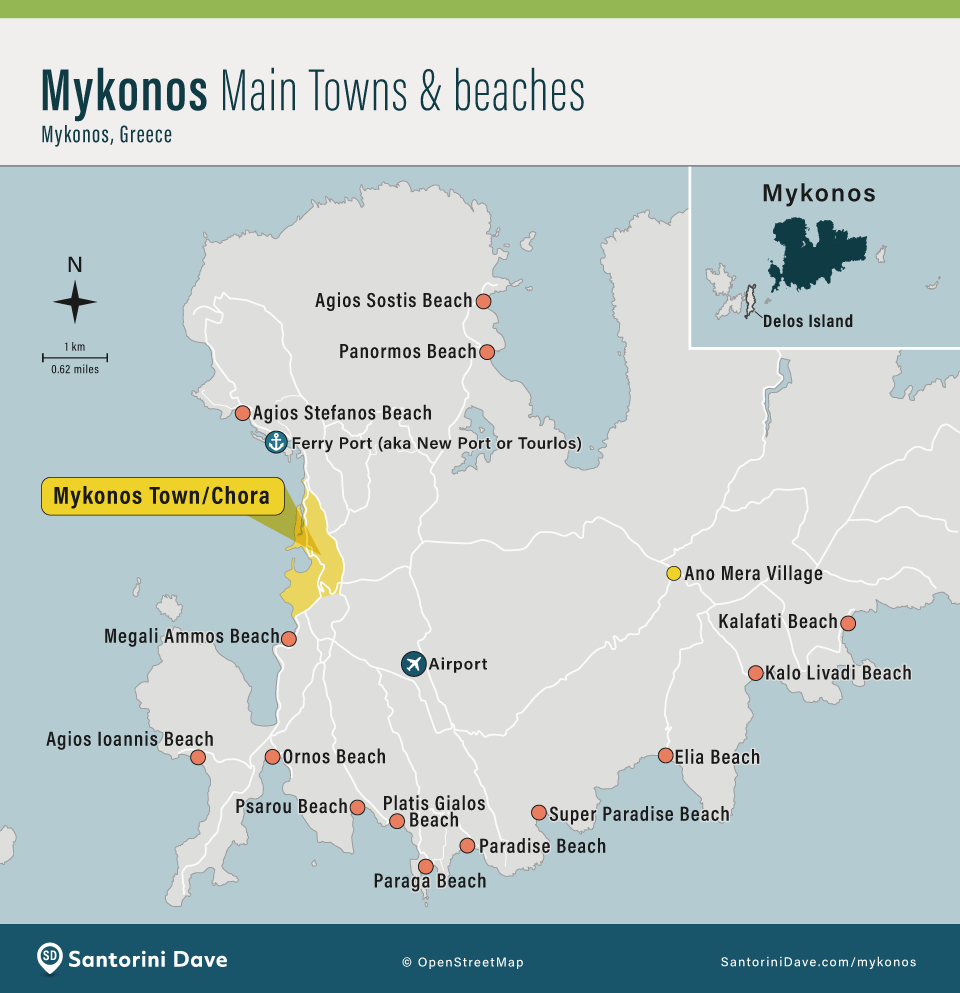
What is the best area to stay in Mykonos?
The island offers distinctly different vibes depending on the location. Whether you want non-stop parties, family-friendly beaches, romantic seclusion, or the buzz of the main town, there’s a spot for you.
Mykonos Town (Chora)
• The Vibe: This is the iconic heart of Mykonos. Think winding, white-washed alleys, bougainvillea spilling over balconies, the famous Windmills, Little Venice’s waterfront bars, chic boutiques, and countless amazing restaurants. It’s bustling, energetic, and incredibly picturesque.
• Pros: Unbeatable atmosphere and charm, the island’s main hub for dining, shopping, and nightlife, location of the main bus stations.
• Cons: Can be noisy and crowded, especially in high season. Hotels within the maze often lack pools or expansive sea views compared to beach resorts. No proper swimming beach right in town (just small patches of sand). Parking is virtually impossible.
• Best For: First-time visitors wanting the quintessential Mykonos experience, nightlife lovers wanting variety, shoppers, those who prioritize convenience and atmosphere over immediate beach access. I recommend staying here if you want easy access to the most restaurants and bars.Ornos Beach
• The Vibe: A wide, sandy bay with calm, shallow waters, lined with restaurants and hotels. Very popular, particularly with families and couples. Lively but much more relaxed than the party beaches.
• Pros: Beautiful, sheltered beach great for swimming. Lots of dining options right on the sand. Frequent bus service to Mykonos Town. Water taxi stop connecting to other southern beaches. Good mix of hotels, including luxury options like Santa Marina Resort & Villas (a top family pick) and Kivotos Mykonos.
• Cons: The beach itself gets extremely crowded in July and August.
• Best For: Families with children, couples wanting a beautiful and convenient beach base that’s not overly focused on partying.
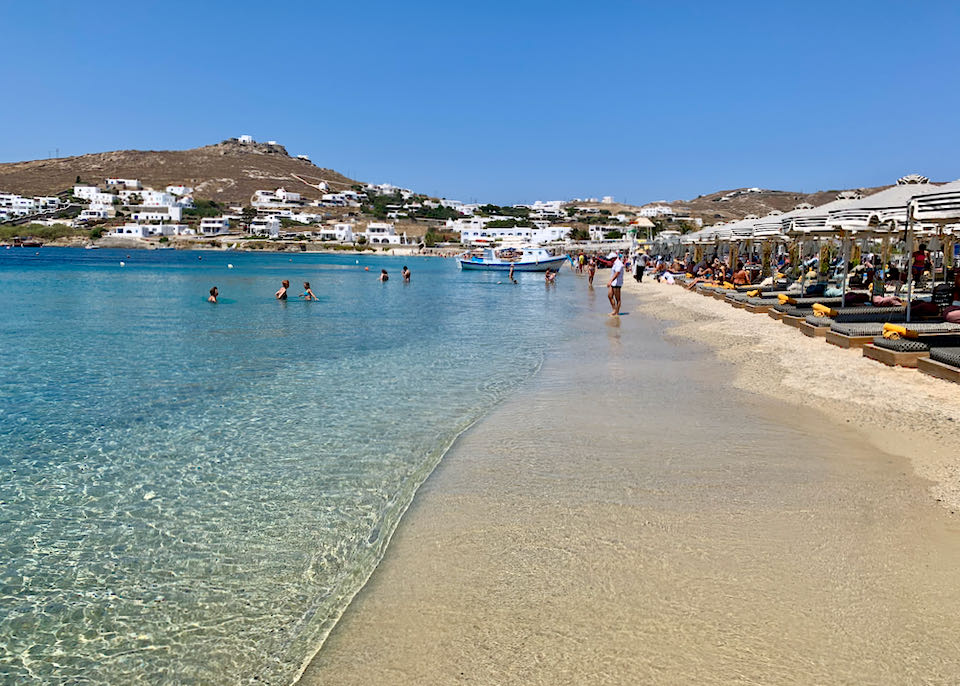
Beautiful Ornos Beach – my favorite beach on Mykonos.
Platis Gialos Beach
• The Vibe: Another stunning, long sandy beach that acts as a major hub. It’s bustling with activity – sunbathers, water sports, people coming and going via buses and boats. Lots of hotels and restaurants directly on or just behind the beach.
• Pros: Fantastic beach. Excellent transportation links – frequent buses to Mykonos Town and the main water taxi station for hopping to Paradise, Super Paradise, and Elia. Wide range of accommodation from mid-range to luxury (like personal favorites Branco Mykonos and Petasos Beach Resort & Spa). Plenty of restaurants.
• Cons: Can feel very busy and tourist-centric, especially the beach itself during peak season.
• Best For: Beach lovers who want maximum convenience for exploring other beaches and easy access to town. It’s arguably the best all-around base if you want a mix of beach time and exploring.Psarou Beach
• The Vibe: Chic, trendy, and expensive. This beautiful, sheltered cove is home to the world-famous Nammos beach club and restaurant, attracting a glamorous, international crowd (and often celebrities). The vibe is luxurious and sophisticated.
• Pros: Gorgeous, calm beach ideal for swimming. High-end dining and designer shopping (Nammos Village). Sense of exclusivity. Home to the luxurious Mykonos Blu hotel.
• Cons: Extremely expensive expect high prices for everything from sunbeds (€150+ often) to food and accommodation. Can feel a bit “scene-y”. Not directly served by the water taxi (short walk over headland to Platis Gialos).
• Best For: Luxury travelers, those wanting the specific Nammos experience, people-watching enthusiasts with a generous budget.Paradise / Super Paradise Beaches
• The Vibe: These are the legendary party beaches. Expect loud music pumping from famous beach clubs (like Tropicana at Paradise, Super Paradise Beach Club) starting in the afternoon and often going late into the night (especially at nearby Cavo Paradiso club). The crowd is generally younger and here to party.
• Pros: You are steps away from the non-stop party scene. Iconic beach clubs are right there. Energetic, fun atmosphere if that’s what you seek. Some decent accommodation options like Tropicana Hotel (Paradise) or Super Paradise Hotel.
• Cons: Noise can be constant. Might feel isolated from the charm and broader attractions of Mykonos Town, especially if you aren’t participating in the party scene. Accommodation will be more basic or solely focused on party access.
• Best For: Dedicated partiers (typically 18-30s) whose main goal is to experience the famous Mykonos beach club scene day and night.Other Great Options:
• Agios Ioannis: Quieter, known for beautiful sunsets (where the movie Shirley Valentine was filmed), home to upscale resorts like Mykonos Grand Hotel & Resort. Good for relaxation near Ornos.
• Elia: One of Mykonos’ longest sandy beaches. LGBTQ+-friendly vibe, well-organized with a mix of relaxed spots and some beach club action. Further from town but has bus access and luxurious hotels like the Myconian Villa Collection.
• Kalafatis: Popular with windsurfers due to breezier conditions. More laid-back feel, good for families seeking water sports.Paradise Beach in Mykonos.
Where Should I Stay for Nightlife and Parties?
• Mykonos Town: This is your best bet if you want variety and easy access to numerous bars and clubs that go late into the night. You can wander from sunset cocktails in Little Venice to lively bars like Scandinavian Bar or Jackie O’ (in town), and then onto dance clubs like Void or Astra. You have the most options concentrated here.
• Paradise / Super Paradise: Stay here if your priority is the famous beach club scene. You can stumble out of your hotel and be right at Tropicana or Super Paradise Beach Club. It’s ideal if you plan to spend your days and nights immersed in that specific party atmosphere. Cavo Paradiso, a major open-air nightclub, is also located on the headland near Paradise beach.
• Platis Gialos / Paraga: These locations offer a good compromise. You get a fantastic beach base with plenty of restaurants and atmosphere. You can easily hop on the bus (which runs late in summer) to Mykonos Town for its clubs, or take a short water taxi ride (daytime/early evening) or walk to Paradise and Super Paradise beaches (though don’t walk back in the dark).My Recommendations:
• For the classic Mykonos experience with the most diverse nightlife options (bars, clubs, restaurants), stay in Mykonos Town.
• For a beach-focused holiday with excellent transport links allowing easy access to both town nightlife and daytime beach parties, Platis Gialos is a superb all-around choice. Ornos, also.
• If your trip is all about the beach parties then staying at Paradise or Super Paradise makes the most sense.
• For families, Ornos is my top recommendation due to its calm waters and amenities.
• For luxury and exclusivity, look towards Psarou or high-end resorts in Agios Ioannis or Elia.
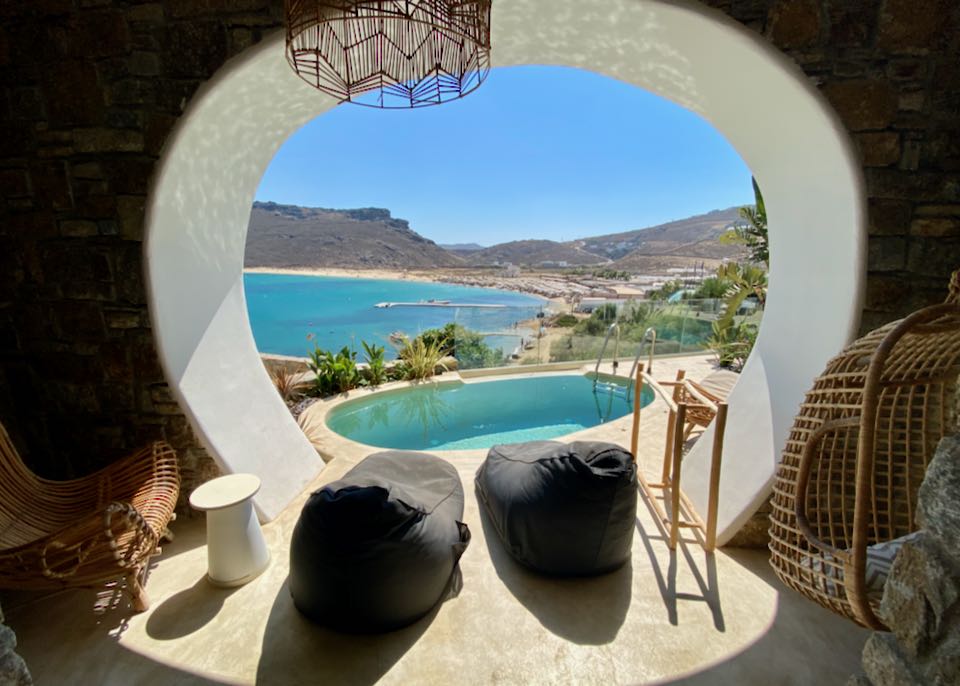
A suite with private plunge pool at Panormos Village Hotel.
What are the best beaches in Mykonos?
Our favorite beaches on Mykonos are Ornos Beach and Platis Gialos Beach. Both are great for families, with many great restaurants, resorts, and beach clubs. It’s easy to visit both of these beaches from Mykonos Town by bus, but staying on the beach is a great option for those who would prefer to avoid the busy Mykonos Town nightlife scene.
1. Ornos Beach
• Beauty: A picturesque, sheltered bay with fine sand and lovely clear water, often dotted with yachts. Very scenic, especially viewed from the surrounding hills.
• Relaxing: While popular, it often feels a bit more relaxed than Platis Gialos.
• Swimming: Fantastic. The bay is very protected, making the water exceptionally calm and clear – ideal for swimming.
• Families: The top family beach due to the super calm, shallow waters, and soft sand. Lots of amenities nearby.
• Couples: Great for couples wanting a beautiful beach close to town with good dining options. Home to high-end romantic hotels like Kivotos Mykonos.
• Restaurants: Excellent selection right on the sand, ranging from traditional Greek at places like Kostantis to more upscale dining at hotel restaurants like Kuzina or Pasaji.2. Platis Gialos Beach
• Beauty: A long, wide crescent of fine golden sand meeting vibrant turquoise water. It’s bustling but beautiful and well-maintained.
• Relaxing: Can be very busy, especially mid-day in high season. Mornings are quieter. Not the top pick if pure tranquility is your goal.
• Swimming: Excellent. Calm, clear waters with a gentle slope, perfect for all ages.
• Families: A favorite due to the calm, shallow water, soft sand, easy bus access, and plentiful amenities.
• Couples: Great for active couples who enjoy convenience, people-watching, and easy access to water taxis for exploring other beaches.
• Restaurants: Loads of options lining the beach, from casual tavernas (Yialo Yialo) to hotel restaurants and cafes (Blue Myth is part of Petinos Hotel here).3. Elia Beach
• Beauty: One of the longest sandy beaches in Mykonos, offering expansive views and beautiful clear water. It feels spacious and less enclosed than some other bays.
• Relaxing: Its size means you can usually find quieter spots away from the main organised sections. It strikes a good balance between organised comfort and a more natural feel.
• Swimming: Excellent, clear water and sandy bottom. Great for a proper swim.
• Families: Good choice, plenty of space for kids to play. Water sports are available for older kids/adults.
• Couples: Very popular with couples and the LGBTQ+ community. Offers a sophisticated yet relaxed vibe. Plenty of space to find your own spot. Home to luxurious resorts like the Myconian Utopia Relais & Chateaux.
• Restaurants: Several good tavernas and hotel restaurants are spaced along the beach, offering variety without being overwhelming.4. Agios Ioannis Beach
• Beauty: Exceptionally scenic, famous for its stunning views across to the island of Delos, especially at sunset. Soft sand and clear turquoise water, though actual beach is on the small size. Known as the “Shirley Valentine” beach.
• Relaxing: Quieter and more peaceful than the beaches closer to town or the party hotspots. Since it’s smaller can feel busy at times.
• Swimming: Wonderful calm, clear waters perfect for a relaxing swim or snorkel.
• Families: Good for families seeking calm waters and a less crowded environment.
• Couples: Highly recommended for romance, particularly for the incredible sunsets and tranquil atmosphere. Home to luxurious, romantic hotels like Mykonos Grand Hotel & Resort and Katikies Mykonos.
• Restaurants: Fewer options than Ornos or Platis Gialos, but high quality, including the well-known Hippie Fish.5. Psarou Beach
• Beauty: A perfectly manicured, small cove with incredibly clear, calm emerald and turquoise water. Often has impressive yachts anchored offshore. Feels exclusive.
• Relaxing: Can be relaxing if you’re settled into a (very expensive) sunbed, but the atmosphere is more about seeing and being seen.
• Swimming: Perfect conditions – very sheltered, calm, and clear.
• Families: Water is ideal, but the high cost and glamorous vibe might make it less suitable for young families.
• Couples: Favored by couples seeking luxury, glamour, and a high-end beach club experience. Home to Mykonos Blu hotel.
• Restaurants: Dominated by the world-famous, high-end Nammos Restaurant and Beach Club.6. Kapari Beach
• Beauty: A small, hidden cove near Agios Ioannis, offering raw, natural beauty with sand and rocks. Feels like a secret spot.
• Relaxing: Extremely relaxing due to its secluded, undeveloped nature. No loud music or rows of sunbeds.
• Swimming: Fantastic clear water for swimming.
• Families: Not ideal due to lack of facilities and slightly tricky access down a path.
• Couples: One of the most romantic spots for couples seeking privacy, natural beauty, and amazing sunset views away from everyone else.
• Restaurants: None. Bring your own water and snacks.7. Agios Sostis Beach
• Beauty: A long, beautiful stretch of golden sand on the wilder north coast. Completely undeveloped and natural.
• Relaxing: Superb choice for relaxation and escaping the crowds. Very peaceful atmosphere.
• Swimming: Great swimming in clear water, though it can be affected by the northern ‘Meltemi’ wind.
• Families: Possible, but the lack of amenities and potential for wind/waves should be a consideration.
• Couples: Wonderful for couples wanting tranquility and natural beauty. Nudism is common here.
• Restaurants: No facilities on the beach itself, but the legendary, rustic Kiki’s Tavern sits just above (no sign, no phone, expect long queues).Other Beautiful Beaches:
• Lia Beach: Further east, quieter, great for snorkeling, has good facilities including a nice beach restaurant.
• Kalo Livadi Beach: Long sandy beach, shallow waters good for families, known for stylish beach clubs like Solymar.
• Kalafatis Beach: Popular for windsurfing, long sandy stretch, family-friendly with facilities.
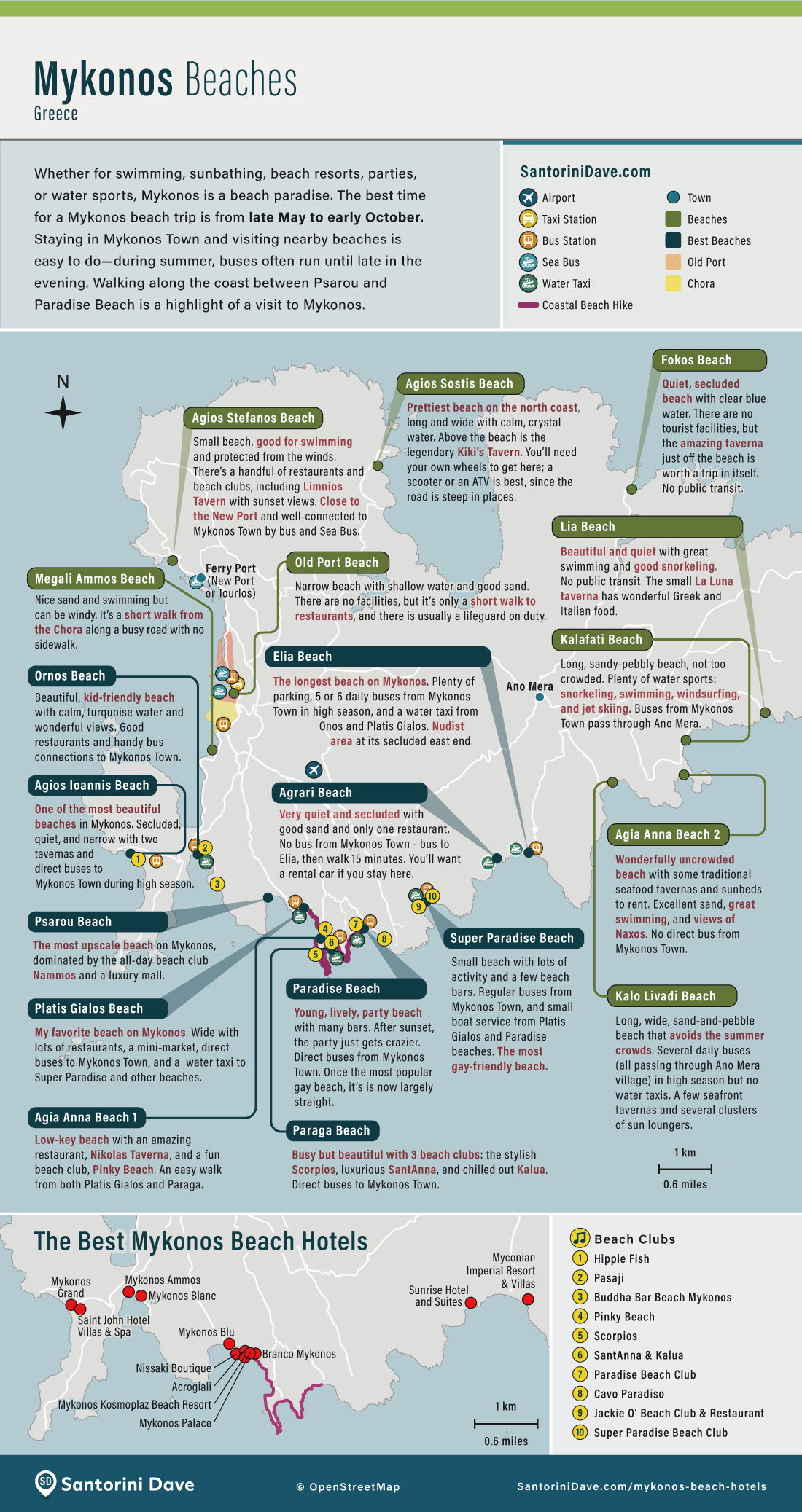
What are the best or most famous beach clubs in Mykonos?
1. Nammos (Psarou Beach)
The Vibe: The absolute pinnacle of Mykonos luxury and exclusivity. Think pristine beach, superyachts anchored offshore, high fashion, and flowing champagne. It’s glamorous, international, and the place to see and be seen.
Famous For: Attracting celebrities and the international jet-set. Its impeccable service, high-end Mediterranean restaurant (especially seafood), adjacent Nammos Village luxury shopping mall, and eye-watering prices (sunbeds can cost hundreds of Euros, often with hefty minimum spends).
Best For: Those seeking the ultimate luxury beach experience and don’t mind the splurge.2. Scorpios (Paraga Beach)
The Vibe: Bohemian-chic meets rustic luxury with a unique spiritual, communal vibe. Built around contemporary interpretations of the ancient Greek ‘agora’ (gathering place), it focuses on sunset rituals, music, wellness, and art. Stunning design using natural materials.
Famous For: Its iconic sunset music rituals where live musicians and DJs create an electrifying atmosphere as the sun goes down. Its unique holistic approach, beautiful design, and stylish international crowd.
Best For: Trendsetters, creatives, and those looking for a more curated, atmospheric experience than just a straightforward party. Reservations are crucial, especially for sunset. Expect high prices and minimum spends for tables.3. Principote (Panormos Beach)
The Vibe: Expansive, elegant, and sophisticated luxury on the beautiful, less crowded Panormos beach (on the north coast). It focuses on providing a high-end, comfortable seaside experience with discreet service.
Famous For: Its stunning design featuring huge, handcrafted crochet umbrellas, luxurious sunbeds, and a focus on refined Mediterranean dining. Offers a more serene kind of luxury compared to the south coast party spots.
Best For: Those seeking upscale relaxation, excellent food, and top-tier service in a beautiful, slightly more remote setting. Prices are very high; reservations essential.4. Tropicana (Paradise Beach)
The Vibe: Legendary, high-energy, non-stop beach party central. Famous for its wild afternoon parties that escalate throughout the day. Expect loud EDM/house music, MCs, dancing on tables, and a very lively, uninhibited atmosphere.
Famous For: Being one of the original and most intense party spots on Mykonos. Its daily beach parties are iconic.
Best For: Younger crowds (18-30s) looking for a classic, full-on Mykonos party experience right on the sand. Relatively more ‘affordable’ than the luxury clubs, but drinks are still pricey.5. Paradise Beach Club (Paradise Beach)
The Vibe: Very similar to Tropicana – loud, energetic, and focused on partying day and night. Shares the famous Paradise Beach location.
Famous For: Being another pillar of the Paradise Beach party scene, often hosting well-known DJs and events.
Best For: Party-goers looking for high-energy fun and dancing on the beach.6. Super Paradise Beach Club (Super Paradise Beach)
The Vibe: Vibrant, energetic party atmosphere in a beautiful cove. Historically known for being very LGBTQ+-friendly, it now attracts a diverse international crowd ready to party.
Famous For: Its inclusive vibe and lively afternoon/evening parties right on the beach.
Best For: Anyone looking for a fun, high-energy beach party in a stunning setting.7. Jackie O’ Beach Club (Super Paradise Beach)
The Vibe: Absolutely fabulous! Glamorous, fun, theatrical, and predominantly LGBTQ+ but welcoming to everyone who loves a good time.
Famous For: Its spectacular sunset drag shows – a Mykonos institution! Also known for great cocktails, a lively pool scene, and a generally joyful atmosphere.
Best For: Experiencing the iconic drag shows, enjoying great music and cocktails in a vibrant, inclusive setting.8. SantAnna (Paraga Beach)
The Vibe: A sprawling luxury beach complex offering a slightly more relaxed party atmosphere than Paradise/Super Paradise, centered around a massive pool.
Famous For: Having one of Europe’s largest saltwater swimming pools, offering VIP ‘islands’ within the pool (some with private underwater suites!), sushi, and international DJs.
Best For: Those who love a poolside party, want luxury amenities, and enjoy a mix of DJ sets and live music. Cabanas and VIP areas come with significant minimum spends.9. Alemagou (Ftelia Beach)
The Vibe: Bohemian, relaxed-chic on the wilder, windier northern Ftelia Beach (a spot popular with windsurfers). Design blends beautifully with the rugged landscape.
Famous For: Its cool, laid-back atmosphere, unique design aesthetic, great cocktails, and offering an alternative to the intense south coast party scene.
Best For: Stylish crowds looking for a more chilled-out, atmospheric beach day with good music and food.10. Solymar (Kalo Livadi Beach)
The Vibe: Elegant and comfortable luxury on the long, beautiful Kalo Livadi beach. It’s upscale but often feels more relaxed and welcoming to families and couples compared to the more exclusive or party-hard clubs.
Famous For: Its excellent Mediterranean restaurant (especially seafood), stylish setting, and prime location on a great sandy beach.
Best For: A sophisticated beach day with fantastic food, suitable for couples, groups, and even families looking for an upscale but not overly intense experience.Do I need a car in Mykonos?
No, a car is not necessary for most visitors, especially if you are staying in Mykonos Town or on a major beach. However, it is helpful (almost essential) if you want to explore the remote northern beaches.
- The Bus is Great for Beaches: The public bus service (KTEL) is excellent. It’s cheap, frequent, and reliable. Buses run constantly between Mykonos Town (the two main stations are Fabrika and Old Port) and the popular south coast beaches like Platis Gialos, Paradise, and Super Paradise.
- Renting a Car: Renting a car gives you freedom to escape the crowds. Do this if you want to visit Ano Mera, the lighthouse, or the quiet northern beaches (Agios Sostis, Panormos). Warning: Parking in Mykonos Town is extremely difficult and expensive. If you rent a car, ensure your hotel has parking.
- The Taxi Problem: There are extremely few taxis (roughly 30) for the entire island. You cannot rely on hailing one, especially at night or at the port.
- Arrival Tip: Don’t arrive at the ferry port or airport without a plan. Taxis are almost impossible to find upon arrival. Arrange a private transfer in advance through your hotel or Welcome Pickups.
What are the must-see sights in Mykonos?
Taking a cooking class or a tour is a great way to get to know Mykonos and some of its locals. Some of our favorite Mykonos tours include the Half-Day Highlights of Mykonos tour, South Coast Sailing and Snorkeling Tour, and the Guided Tour to Delos Island.
1. Delos Island (Day Trip)
• What it is: A small, uninhabited island a short (30-45 min) ferry ride from the Mykonos Old Port. It’s one of Greece’s most important archaeological sites, a UNESCO World Heritage treasure, and the mythical birthplace of twin gods Apollo (god of sun, light, music) and Artemis (goddess of the hunt, moon).
• Why it’s a Must-See: The entire island is an open-air museum filled with extensive ruins of temples, sanctuaries, a theatre, marketplaces, and luxurious houses adorned with incredible, well-preserved mosaics. Walking the Avenue of the Lions is unforgettable. It offers a profound glimpse into ancient Greek life, religion, and commerce. This is the essential cultural excursion from Mykonos and one of the top historical sites in all of Greece.
• Tip: Take a guided tour – the context provided by a knowledgeable guide is crucial to understanding the sprawling site. Wear comfortable shoes, a hat, and sunscreen as there’s very little shade. Allow at least 3-4 hours for the visit.2. Little Venice (Mykonos Town)
• What it is: A charming cluster of historic, colorful fishing houses built right on the sea’s edge in Mykonos Town (Chora), with wooden balconies hanging over the waves. Built mainly in the 18th century by wealthy sea merchants, their location allowed direct access for loading and unloading goods (and maybe some sly pirate dealings).
• Why it’s a Must-See: It’s impossibly picturesque and wildly romantic, especially at sunset. The combination of Cycladic architecture meeting the Aegean Sea is unique. It’s buzzing with cafes and bars, perfect for grabbing a drink and soaking in the atmosphere. One of the most photographed spots on the island.
• Tip: Get there well before sunset if you want a prime seat at a waterfront bar. Even just wandering through during the day is magical.3. The Kato Mili (Windmills of Mykonos)
• What it is: The iconic row of whitewashed, cylindrical windmills standing prominently on the hill overlooking Little Venice and the sea. Dating back to the Venetian era, these were workhorses, using the island’s reliable winds to grind grain, primarily wheat and barley, which was vital for the local economy and for supplying ships.
• Why it’s a Must-See: Instantly recognizable and incredibly photogenic. The view from the windmills over Little Venice and the surrounding sea is spectacular, especially at sunset. They represent a fascinating part of the island’s agricultural and maritime history.
• Tip: You can walk up anytime for photos and views. Boni’s Windmill, slightly further into town, is part of the Agricultural Museum and sometimes open to view the inner workings.4. Wandering the Labyrinth of Mykonos Town (Chora)
• What it is: While Little Venice and the Windmills are specific spots, the entirety of Mykonos Town’s core is an attraction in itself. It’s a captivating maze of narrow, winding, stone-paved alleys, whitewashed cubic houses with colourful doors and shutters, tiny churches, hidden squares, and bougainvillea tumbling over walls. This layout wasn’t just for aesthetics; it was a defensive measure designed to confuse invading pirates.
• Why it’s a Must-See: Getting deliberately “lost” here is one of the purest Mykonos joys. Every corner reveals something new – a chic boutique, a traditional bakery, a sleeping cat, a perfect photo opportunity. It’s about soaking up the unique Cycladic atmosphere and discovering hidden gems away from the main thoroughfares.
• Tip: Put away the map for a while and just follow your curiosity. The town is small enough that you can’t get truly lost for long, and you’ll eventually find your way back to the harbour or a main square. Early mornings are magical when the streets are quiet.5. Panagia Paraportiani Church (Mykonos Town)
• What it is: Located in the Kastro (Castle) district near the Old Port, this isn’t just one church, but a stunning asymmetrical cluster of five small, whitewashed chapels built gradually between the 15th and 17th centuries. Four form the base, and the main domed church sits atop them. Its name translates to “Our Lady of the Side Gate,” referring to its position near the entrance of the medieval castle that once stood here.
• Why it’s a Must-See: It’s an architectural marvel and one of the most unique religious buildings in Greece. Its smooth, flowing, whitewashed form against the blue sky is beautiful. It’s a designated National Cultural Monument.
• Tip: It’s rarely open to go inside, but the exterior is the main attraction. The light seems (to me) particularly beautiful in the late afternoon.6. Aegean Maritime Museum (Mykonos Town)
• What it is: Located in a traditional 19th-century Mykonian building in the Tria Pigadia area of Chora, this small but fascinating museum is dedicated to Greece’s rich nautical history and traditions, with a special focus on the Aegean Sea and Mykonos’s role within it.
• Why it’s a Must-See: Mykonos’s identity and history are deeply intertwined with the sea. You’ll find beautiful models of ships from pre-Minoan times to the present day, historical charts, engravings, rare navigational instruments, old anchors, and even the original Fresnel lens mechanism from the Armenistis Lighthouse. It provides a wonderful cultural counterpoint to the island’s more glamorous side and helps you appreciate the seafaring heritage that shaped it.
• Tip: It’s not a huge museum, so you can explore it thoroughly in about an hour. Check its opening hours, as they can vary, especially outside the peak summer season.7. Ano Mera Village & Panagia Tourliani Monastery
• What it is: Located roughly in the center of the island (about 8km from Mykonos Town), Ano Mera is the island’s primary traditional village. It offers a quieter, more authentic contrast to the bustling coast, centered around a charming main square lined with local tavernas. Its main landmark is the beautiful Monastery of Panagia Tourliani.
• Why it’s a Must-See: It shows you a different side of Mykonos – a glimpse into traditional village life. The Monastery (founded 1542) is stunning, with an impressive carved marble bell tower and a magnificent, ornate wooden iconostasis (altar screen) inside, considered a masterpiece.
• Tip: Easily reachable by public bus from the Old Port station in Mykonos Town. Enjoy a traditional Greek coffee or meal in the square.8. Paleokastro Monastery (Near Ano Mera)
• What it is: An 18th-century monastery, formerly a nunnery, located on a hill just north of Ano Mera village. Its name means “Old Castle,” likely referring to the ruins of a Byzantine or Venetian castle (Gýzi Castle) situated nearby.
• Why it’s a Must-See: This offers another glimpse into Mykonos’s rich religious history and traditional Cycladic architecture, distinct from the more famous Panagia Tourliani in Ano Mera’s main square. Its hilltop position provides lovely views of the surrounding rural landscape. Near the monastery, you can spot an ancient monolithic granite stone (a menhir).
• Tip: Combine a visit here with your trip to Ano Mera village. You’ll likely need transport (car/scooter) to reach it easily from Ano Mera or Chora. Check if access is permitted, as it’s a working (though small) religious site.9. Armenistis Lighthouse
• What it is: A picturesque, functional lighthouse perched on the rugged northwestern tip of Mykonos (Fanari area), built in 1891 following a shipwreck.
• Why it’s a Must-See: The dramatic cliffside location offers absolutely breathtaking panoramic views over the Aegean Sea towards the island of Tinos. It’s a fantastic, less crowded spot to watch the sunset. The drive or ride out there is scenic in itself, showcasing a wilder side of Mykonos.
• Tip: You’ll need your own transport (rental car, scooter, ATV) or join a specific tour to get here. It can be very windy, so bring an extra layer, especially if visiting for sunset.10. Mykonos Vioma Organic Farm & Vineyard
• What it is: A charming, family-run organic farm and vineyard located in the tranquil countryside near Ano Mera village, in the historic Maou area where monks once tended vines.
• Why it’s a Must-See: Offers a wonderful, authentic glimpse into a completely different side of Mykonos – its agricultural traditions and local production. You can escape the buzz of the coast, wander through vineyards, learn about organic and biodynamic farming practices, meet some friendly farm animals (donkeys, goats, sheep), and, of course, taste unique local wines (like the indigenous varieties Monemvasia and Malagouzia) often paired with delicious Mykonian products like cheese, rusks, and tomatoes.
• Tip: It’s best visited by car/scooter or potentially via a guided tour (like a wine tour or bike tour). Check their visiting hours (usually afternoons, May-October) and consider booking a tasting in advance.
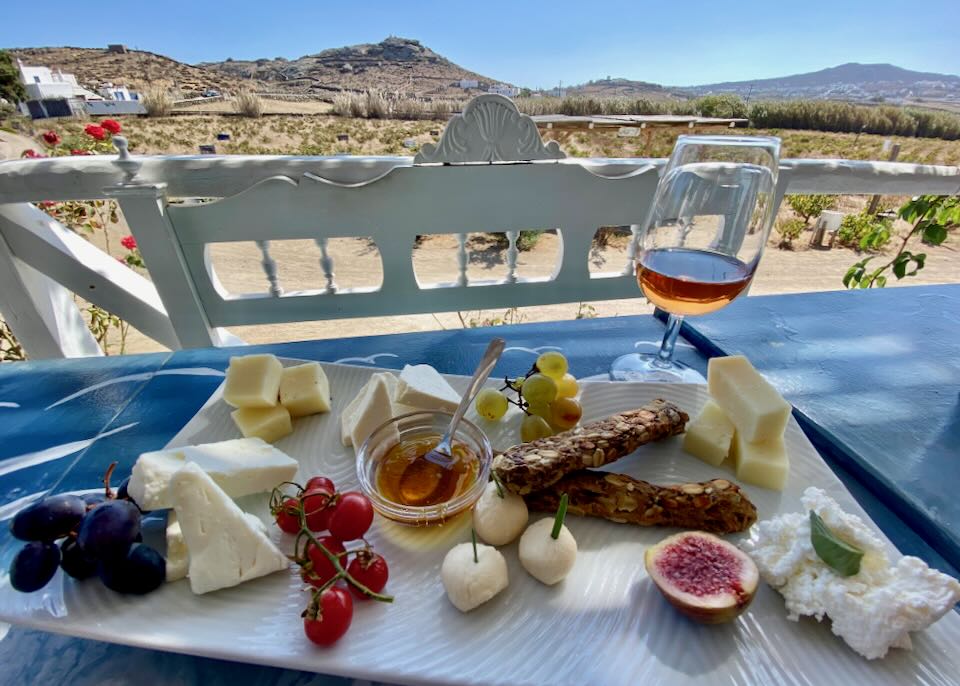
Our stop at the Vioma Organic Farm & Vineyard during the Yummy Pedals Bike Tour.
What are the most romantic areas, beaches, and hotels for couples in Mykonos?
Most Romantic Areas in Mykonos
• Mykonos Town (Chora) – Especially Little Venice: Yes, the main town can be busy, but its charm is undeniable. For romance, focus on Little Venice at sunset – find a table at one of the waterfront bars (like Kastros) and watch the sky change colours over the sea. Get lost together wandering the quiet, labyrinthine backstreets away from the main crowds, discovering hidden chapels and picturesque corners. The sheer number of excellent restaurants also makes it perfect for romantic dinners.
• Agios Ioannis: Located on the southwest coast, this area offers breathtaking views across the water towards the sacred island of Delos, especially at sunset. It’s much quieter and more relaxed than Mykonos Town and the busier south coast beaches. It boasts several high-end resorts perfect for couples seeking tranquility and stunning scenery. It’s the best area for couples looking for a romantic escape.
• Elia Beach: While known for being a long, popular, and LGBTQ+-friendly beach, its size means you can easily find quieter spots. The surrounding hills host some of Mykonos’ most luxurious resorts, offering privacy, amazing sea views, and top-notch amenities ideal for a romantic getaway.
• Aleomandra: This peninsula near Ornos offers a more secluded feel, primarily featuring luxury villas and boutique hotels tucked away with gorgeous sea views. It’s perfect if you value privacy and tranquility above easy access to bustle.Romantic Beaches for Couples
• Kapari Beach: A small, somewhat hidden gem near Agios Ioannis. It’s undeveloped (no sunbeds or cafes, bring your own supplies) but offers beautiful clear water, good sand, and fantastic sunset views. Its secluded feel makes it very romantic.
• Agios Sostis: Located on the northern coast, this is another stunningly natural and undeveloped beach. It has a wild beauty and is perfect for couples wanting to escape the crowds. Again, no facilities, so come prepared. The famous, tiny Kiki’s Tavern is nearby (expect a wait).
• Agios Ioannis Beach: The beach itself is lovely, sandy, and relatively calm. The main draw, as mentioned, is the incredible view and sunset, making it inherently romantic.
• Lia Beach: Further east, Lia is known for its crystal-clear water (great for snorkeling) and more relaxed atmosphere compared to its southern neighbors. It has some organization but generally feels subdued.
• Elia Beach: Given its length, you can find more peaceful sections away from the main hubs, especially towards the ends.A Mykonos Town windmill.
Top Romantic Hotels for Couples
• Bill & Coo Suites and Lounge (Megali Ammos): One of the most romantic hotels, located just outside Mykonos Town. Incredible sea views, stunning infinity pool, luxurious suites (many with private pools/jacuzzis), exceptional service, and acclaimed gastronomy. Perfect for honeymoons.
• Mykonos Grand Hotel & Resort (Agios Ioannis): An elegant beachfront resort offering spacious rooms, a beautiful pool area, excellent spa, attentive service, and direct access to the lovely Agios Ioannis beach with its sunset views.
• Cavo Tagoo Mykonos (near Mykonos Town): An iconic luxury hotel famous for its stunning design, incredible infinity pool with floating sunbeds, cave pool suites, and vibrant atmosphere. Offers breathtaking sea and sunset views.
• Kivotos Mykonos (Ornos): Features unique architecture, beautiful rooms and suites (some with private pools), two pools, a small private beach area, and even a private yacht for excursions. Very romantic ambiance.
• Mykonos Blu (Psarou): Perched above exclusive Psarou beach, this hotel offers Cycladic style, an amazing tiered infinity pool, private bungalows and villas (many with private pools), and direct access (via steps) to Nammos and the glamorous beach below.
• Katikies Mykonos (Agios Ioannis): Part of a renowned luxury hotel group, offering sophisticated Cycladic style, stunning sea views towards Delos, beautiful pools, and impeccable service – ideal for a romantic escape.
• The Wild Hotel by Interni (near Kalafatis): Offers a more bohemian, relaxed luxury vibe. Set above a secluded cove with private access, it feels authentic and stylishly rugged. Great pool, views, and food.
• Adults-Only Options: For guaranteed tranquility, consider adults-only hotels like Ananea Mykonos (Agios Ioannis) or Andronikos Hotel (near Mykonos Town).Romantic Experiences
• Sunset Views: Watch the sunset from Little Venice, the Windmills, Agios Ioannis beach, or a dedicated sunset bar like 180° Sunset Bar (book ahead).
• Private Boat Trip: Charter a boat for a few hours or a day to explore hidden coves, swim in secluded spots, visit Delos and Rhenia, or simply enjoy the sunset from the water.
• Couples Spa Treatment: Many luxury hotels have excellent spas offering treatments for two.
• Romantic Dinner: Choose a restaurant with stunning views (like Karavaki at Vencia Boutique Hotel), a table right by the water in Little Venice, or a fine-dining experience at your hotel or a renowned spot like Spilia Seaside Restaurant (in a cave!).
• Wander Mykonos Town at Dawn/Dusk: Experience the magic of the empty streets early in the morning or just before sunset.
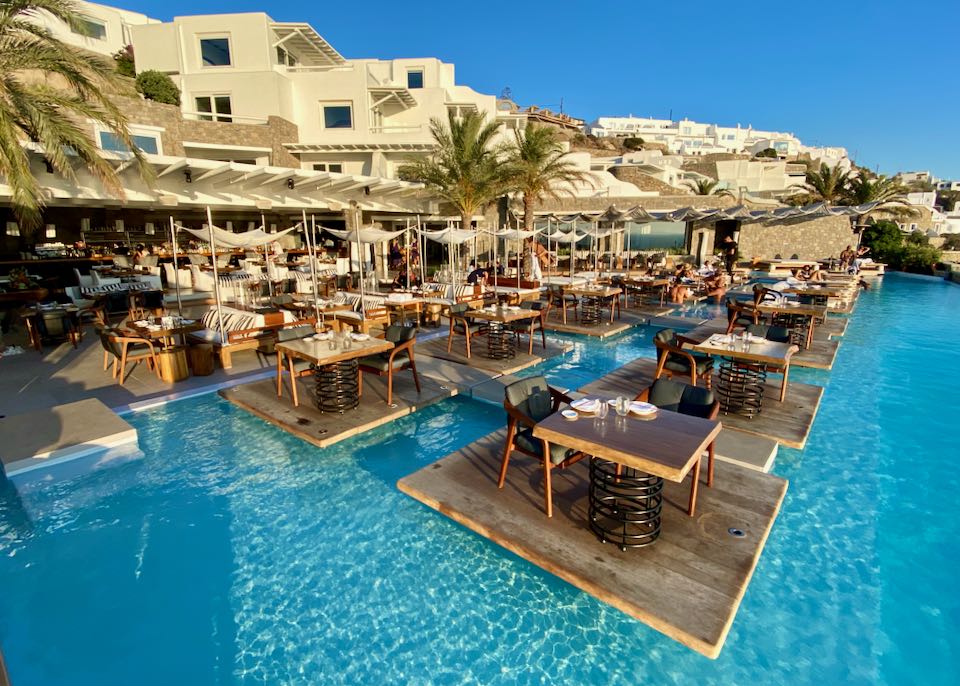
The pool and restaurant at Cavo Tagoo Hotel in Mykonos Town.
What currency is used in Mykonos?
The currency is the Euro (€).
Cash, Credit Cards, and Mobile Pay
- Cards & Mobile Pay: Visa, Mastercard, Apple Pay, and Google Pay are accepted almost everywhere, including restaurants, shops, and beach clubs. American Express is accepted at high-end venues but is less common at smaller shops.
- Cash is Essential: You still need cash for the bus (drivers do not take cards or phones), taxis (many drivers still prefer cash or claim their machine is broken), small kiosks, and tipping.
- ATMs: You will find plenty of ATMs in Mykonos Town, the airport, and the main beach areas like Platis Gialos and Ornos.
Important Tip: Always Pay in Euros
When using your credit card or withdrawing cash from an ATM, the machine will often ask if you want to be charged in Euros (EUR) or your home currency (e.g., USD, GBP). Always choose Euros. If you choose your home currency, the machine applies a poor exchange rate with hidden fees (Dynamic Currency Conversion). Letting your own bank do the conversion is always the cheaper option.Most of our favorite restaurants in Mykonos accept credit cards, like Nikolas Taverna at Agia Anna Beach, but it’s a good idea to have some euros on hand, just in case.
Is Mykonos expensive?
Yes, compared to many other Greek islands and European destinations, Mykonos leans towards the expensive side. It’s known globally for its high-energy nightlife, luxurious hotels, chic boutiques, and glamorous beach clubs, attracting a crowd willing to spend top dollar (or Euro). This is especially true during high season (July and August) when demand skyrockets.
However, while it’s easy to splurge here, you can experience the magic of Mykonos on a more moderate budget with some smart planning. As I often say, choosing accommodations and restaurants slightly away from the prime waterfront spots will make a big difference.
Accommodation
This will likely be your biggest expense. Prices surge in July and August.Budget: Finding truly cheap accommodation in Mykonos during peak season is challenging. Hostels (if you can find availability) range from €50 to €100+ per night for a dorm bed. Budget-friendly private rooms or studios, most often away from Mykonos Town or the most popular beaches, start around €70-€150 per night, but expect basic amenities. Check out places like Pension Matina or Hotel Nazos in Mykonos Town for reliable, well-located, more affordable options. Airbnbs can also offer value, especially for small groups.
Mid-Range: For a comfortable, well-located hotel with a pool and good amenities (in areas like Ornos, Platis Gialos, or just outside Mykonos Town), expect to pay anywhere from €150 to €400+ per night. Hotels like Mykonos Bay Hotel (Megali Ammos) or Petinos Beach Hotel (Platis Gialos) fall into this category.
Luxury: Mykonos excels here. Five-star resorts, villas with private pools, and boutique hotels in prime locations often start at €500-€600 and can easily soar well above €1,000 per night.
Tip: Book accommodation far in advance for high season travel to secure better prices and availability.
Food & Drink
You can eat relatively affordably or indulge in world-class dining.Budget Eats: Grabbing a delicious gyro or souvlaki pita will cost around €4-€7. Bakeries offer cheese pies (tiropita) or spinach pies (spanakopita) for a few Euros – perfect for breakfast or a quick snack. You could manage a food budget of €30-€40 per day if you stick mainly to these options and perhaps supplement with groceries.
Casual Dining (Tavernas): A meal at a standard taverna (away from the most tourist-heavy spots) might cost €20-€40 per person for a main dish and a drink. Look for places in Ano Mera village or on the backstreets of Mykonos Town.
Mid-Range & Upscale Restaurants: Dining at popular restaurants in Mykonos Town (especially Little Venice) or at beach clubs will be pricier. Expect entrées from €25-€50+, with fine dining easily reaching €80-€150+ per person, especially if seafood and wine are involved.
Drinks: A coffee might be €4-€6. Beer can cost €6-€10+. Cocktails are where costs can really add up, typically ranging from €12 to €20+, particularly at sunset bars or beach clubs.
Tip: House wine (ask for krasi hima) is usually much cheaper than bottled wine in tavernas. Avoid restaurants with pushy touts outside or menus with pictures – they often target tourists with inflated prices.
Activities & Getting Around
• Beaches & Sunbeds: Accessing the beaches themselves is free. However, renting a set of sunbeds and an umbrella at organized beaches can be a significant expense. Prices vary wildly: expect €30-€50 at places like Elia, €40-€70 at Paradise or Super Paradise, and €80-€150+ (often with a minimum spend on top) at ultra-chic spots like Nammos (Psarou) or Scorpios. Many beaches have sections where you can lay your own towel for free.
• Beach Clubs & Nightlife: Famous beach clubs might have entry fees (€20-€50+) or high minimum spends, plus those expensive drinks. Entry to nightclubs in town might also involve a cover charge.
• Sightseeing: Exploring Mykonos Town’s charming streets, seeing the Windmills, and visiting Little Venice are free highlights. A trip to the sacred island of Delos costs around €12 for site admission plus ferry (€20) or tour costs (€60+ including transport and guide).
• Tours & Water Sports: Boat trips to explore beaches or enjoy the sunset range from €50 to €150+ per person (more for semi-private and private catamaran tours). Watersports like jet skiing start around €40-€60 for a short session.
• Transportation: The local bus system is efficient and affordable (€2-€5 per trip) for reaching major beaches and villages from Mykonos Town (check schedules at Fabrika or Old Port stations). Taxis are available but pricier (€20-€40+ depending on distance) and can be hard to find at peak times. Renting an ATV (€30-€50/day) or scooter (€20-€40/day) is popular for exploring independently. Car rentals start around €40-€70+ per day.
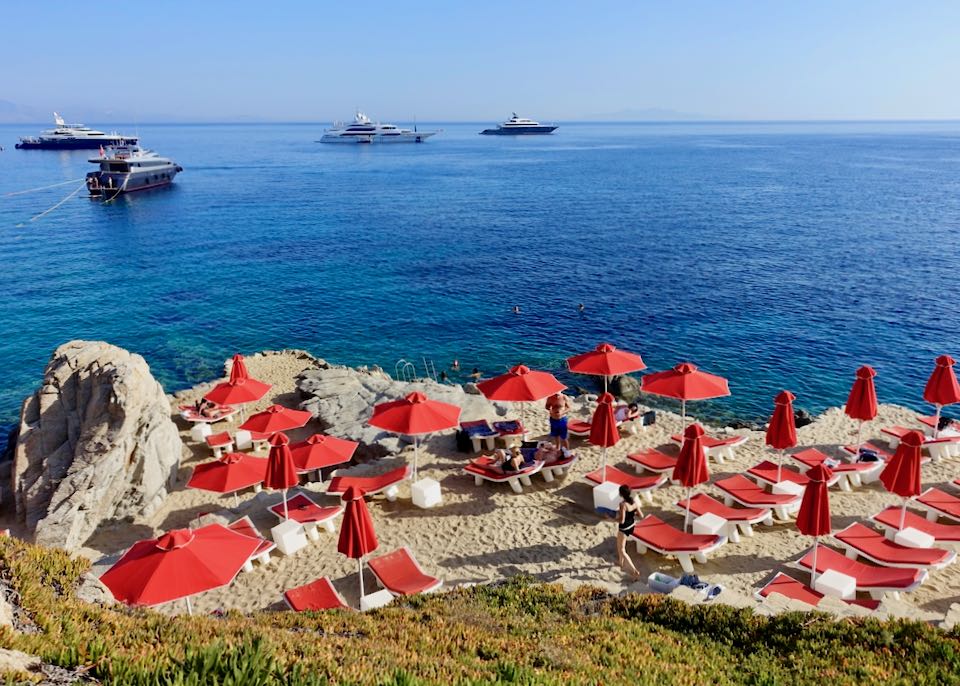
Petasos Beach Resort in Platis Gialos.

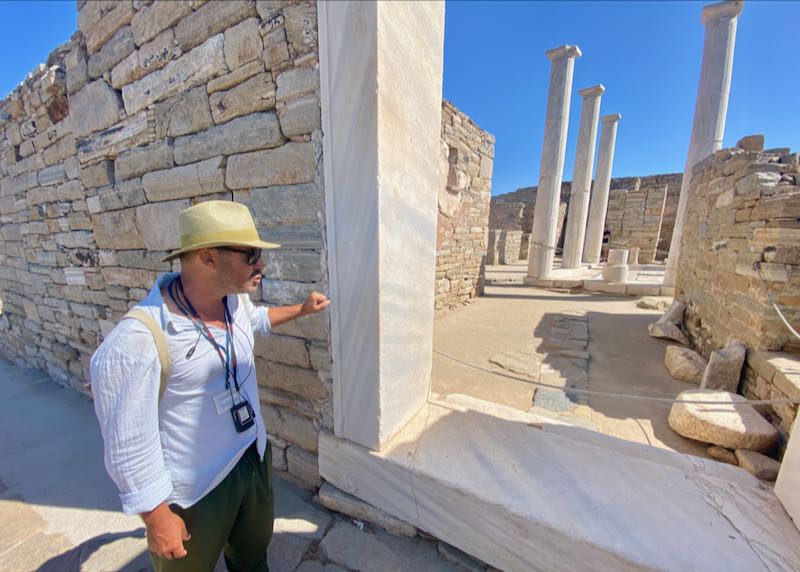
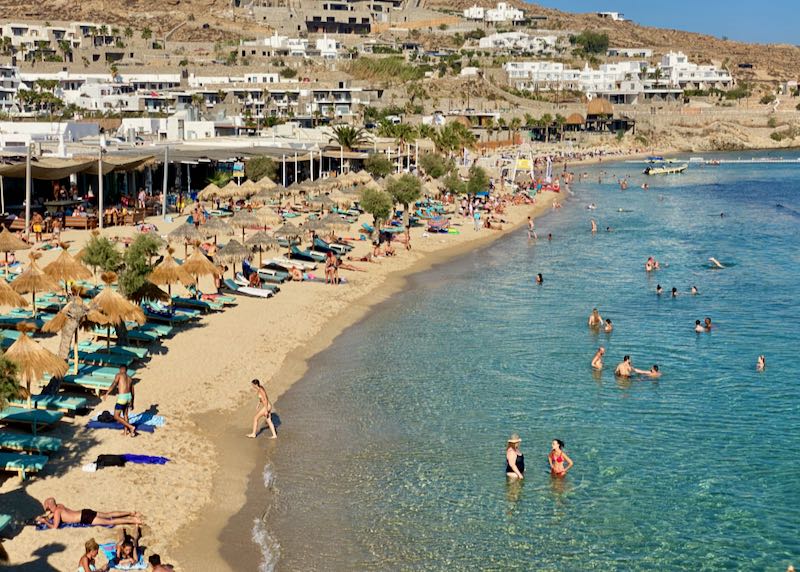
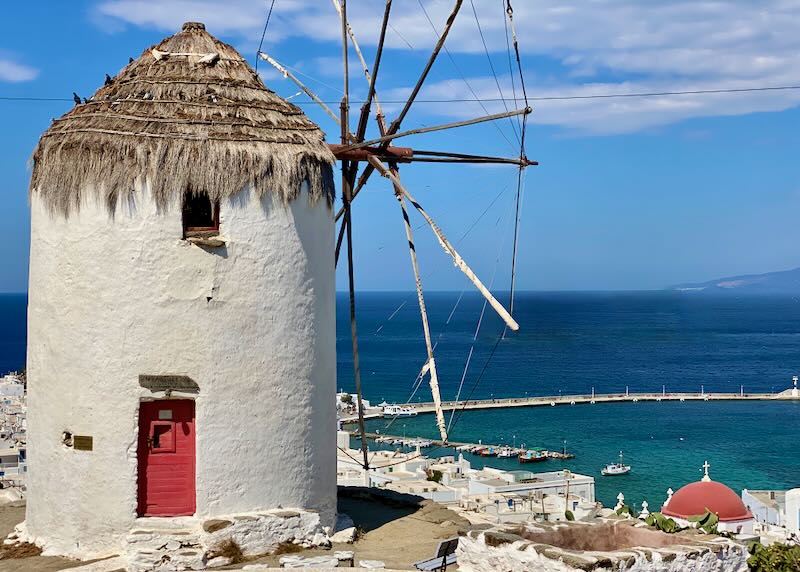
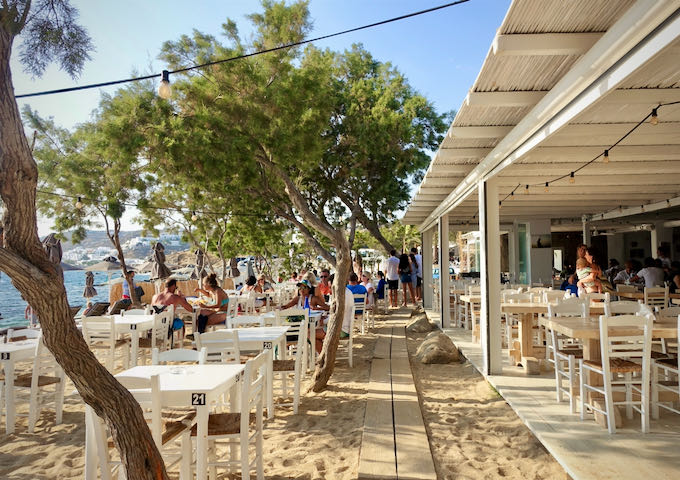
About Santorini Dave